

Compact Muon Solenoid
LHC, CERN
| CMS-EXO-17-001 ; CERN-EP-2017-235 | ||
| Search for low mass vector resonances decaying into quark-antiquark pairs in proton-proton collisions at $\sqrt{s} = $ 13 TeV | ||
| CMS Collaboration | ||
| 30 September 2017 | ||
| JHEP 01 (2018) 097 | ||
| Abstract: A search for narrow vector resonances decaying into quark-antiquark pairs is presented. The analysis is based on data collected in proton-proton collisions at $\sqrt{s} = $ 13 TeV with the CMS detector at the LHC, corresponding to an integrated luminosity of 35.9 fb$^{-1}$. The hypothetical resonance is produced with sufficiently high transverse momentum that its decay products are merged into a single jet with two-prong substructure. A signal would be identified as a peak over a smoothly falling background in the distribution of the invariant mass of the jet, using novel jet substructure techniques. No evidence for such a resonance is observed within the mass range of 50-300 GeV. Upper limits at 95% confidence level are set on the production cross section, and presented in a mass-coupling parameter space. The limits further constrain simplified models of dark matter production involving a mediator interacting between quarks and dark matter particles through a vector or axial-vector current. In the framework of these models, the results are the most sensitive to date, extending for the first time the search region to masses below 100 GeV. | ||
| Links: e-print arXiv:1710.00159 [hep-ex] (PDF) ; CDS record ; inSPIRE record ; CADI line (restricted) ; | ||
| Figures | |
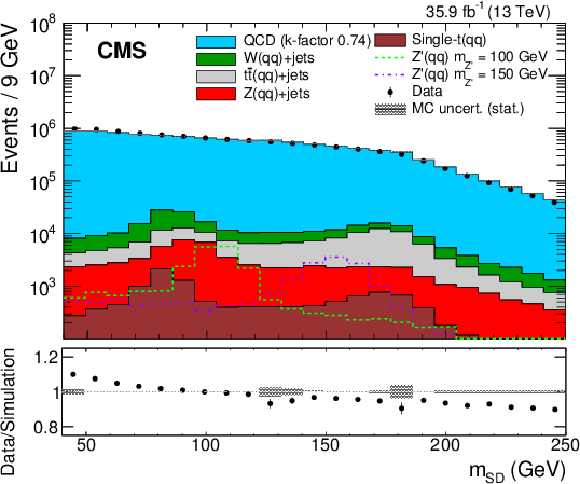
png pdf |
Figure 1:
Distributions of data (points) and simulated backgrounds (histograms), of the leading $ {p_{\mathrm {T}}} $ jet soft-drop mass after the jet kinematic selection. Dashed lines illustrate the signal contribution for different Z' boson masses. The multijet processes (QCD) dominate the background component, with subdominant contributions from inclusive SM W, Z, and ${\mathrm{t} {}\mathrm{\bar{t}}} $ and single top quark processes. The QCD simulation is corrected by an overall factor of 0.74 to match the data yield. |
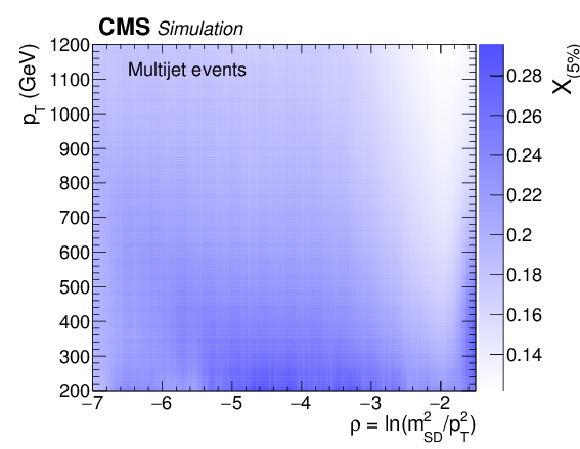
png pdf |
Figure 2:
The distribution of $ X_{ 5-\text{percent} } $ used to define the $N_2^{1,\text {DDT}}$ variable, corresponding to the 5% quantile of the $N_2^{1}$ distribution in simulated multijet events. The distribution is shown as a function of the jet $\rho $ and $ {p_{\mathrm {T}}} $ and smoothed using a kNN approach [64]. The $N_2^{1}$ distribution is mostly insensitive to the jet $\rho $ and $ {p_{\mathrm {T}}} $ in the kinematic phase space considered for this analysis ($-5.5 < \rho < -2.0$). Residual correlations in simulation are corrected by applying a decorrelation procedure that yields the $N_2^{1,\text {DDT}}$ variable. |
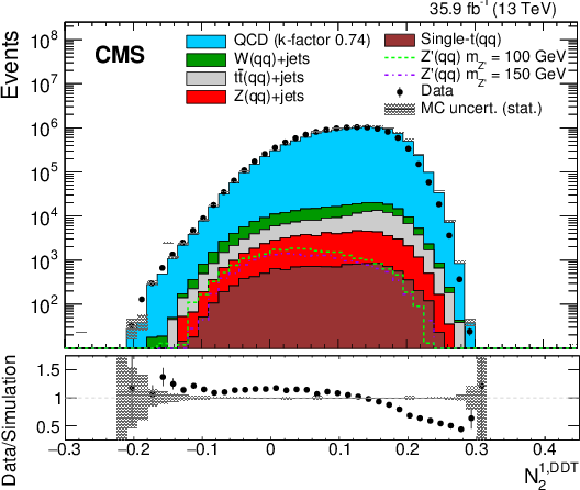
png pdf |
Figure 3:
Distributions of data (points) and simulated backgrounds (histograms), of the $N_2^{1,\text {DDT}}$ variable for the leading $ {p_{\mathrm {T}}} $ jet after the kinematic selection. Dashed lines illustrate the signal contribution for different Z' boson masses. The multijet processes (QCD) dominate the background component, with subdominant contributions from inclusive SM W, Z, and ${\mathrm{t} {}\mathrm{\bar{t}}} $ and single top quark processes. The QCD simulation is corrected by an overall factor of 0.74 to match the data yield. |

png pdf |
Figure 4:
A schematic of the background estimation method. The pass-to-fail ratio, $R_{\rm p/f}(\rho (m_\text {SD}, {p_{\mathrm {T}}}))$, is defined from the events passing and failing the $N_2^\text {1,DDT}$ selection. The variable $N_2^\text {1,DDT}$ is constructed so that, for simulated multijet events, $R_{\rm p/f}$ is constant (left). To account for residual differences between data and simulation, $R_{\rm p/f}$ is extracted by performing a two-dimensional fit to data in ($ \rho, {p_{\mathrm {T}}} $) space (right). |
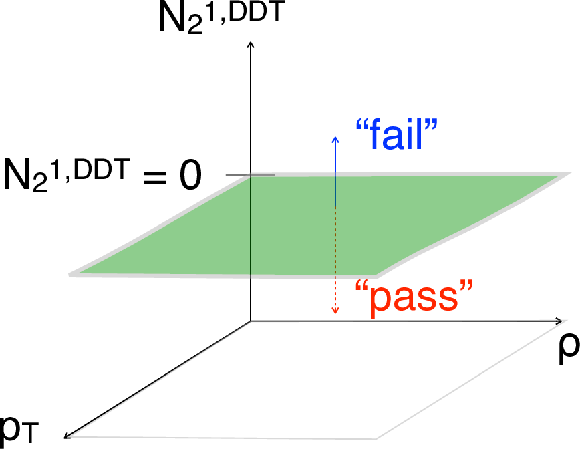
png pdf |
Figure 4-a:
A schematic of the background estimation method. The pass-to-fail ratio, $R_{\rm p/f}(\rho (m_\text {SD}, {p_{\mathrm {T}}}))$, is defined from the events passing and failing the $N_2^\text {1,DDT}$ selection. The variable $N_2^\text {1,DDT}$ is constructed so that, for simulated multijet events, $R_{\rm p/f}$ is constant. |

png pdf |
Figure 4-b:
A schematic of the background estimation method. The pass-to-fail ratio, $R_{\rm p/f}(\rho (m_\text {SD}, {p_{\mathrm {T}}}))$, is defined from the events passing and failing the $N_2^\text {1,DDT}$ selection. To account for residual differences between data and simulation, $R_{\rm p/f}$ is extracted by performing a two-dimensional fit to data in ($ \rho, {p_{\mathrm {T}}} $) space. |

png pdf |
Figure 5:
Soft-drop jet mass distributions that pass (left) and fail (right) the $N_{2}^\text {1,DDT}$ selection in the semileptonic ${\mathrm{t} {}\mathrm{\bar{t}}} $ sample. Results of fits to data and simulation are shown. |
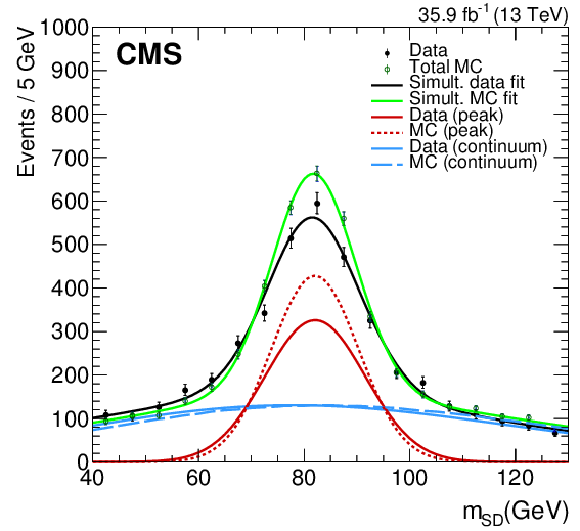
png pdf |
Figure 5-a:
Soft-drop jet mass distributions that pass the $N_{2}^\text {1,DDT}$ selection in the semileptonic ${\mathrm{t} {}\mathrm{\bar{t}}} $ sample. Results of fits to data and simulation are shown. |

png pdf |
Figure 5-b:
Soft-drop jet mass distributions that fail the $N_{2}^\text {1,DDT}$ selection in the semileptonic ${\mathrm{t} {}\mathrm{\bar{t}}} $ sample. Results of fits to data and simulation are shown. |

png pdf |
Figure 6:
Soft-drop jet mass distribution for the different ${p_{\mathrm {T}}}$ ranges of the fit from 500 to 1000 GeV. Data are shown as black points. The multijet background prediction, including uncertainties, is shown by the shaded bands. Contributions from the W and Z boson, and top quark background processes, and a hypothetical Z' boson signal at a mass of 135 GeV are also indicated. In the bottom panel, the ratio of the data to the background prediction, including uncertainties, is shown. The scale on the x-axis differs for each ${p_{\mathrm {T}}}$ range due to the kinematic selection on $\rho $. |
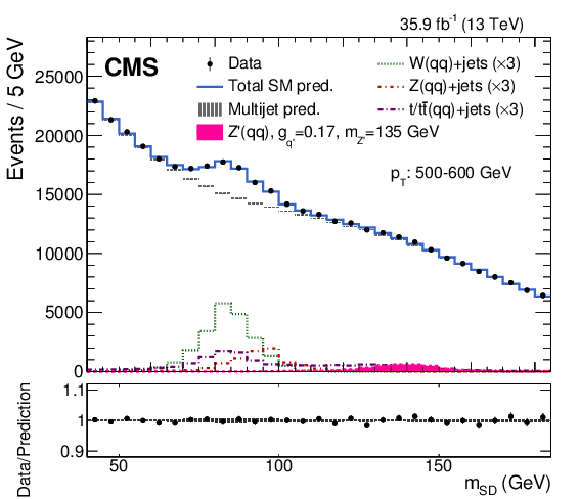
png pdf |
Figure 6-a:
Soft-drop jet mass distribution for the ${p_{\mathrm {T}}}$ range of the fit from 500 to 600 GeV. Data are shown as black points. The multijet background prediction, including uncertainties, is shown by the shaded bands. Contributions from the W and Z boson, and top quark background processes, and a hypothetical Z' boson signal at a mass of 135 GeV are also indicated. In the bottom panel, the ratio of the data to the background prediction, including uncertainties, is shown. |
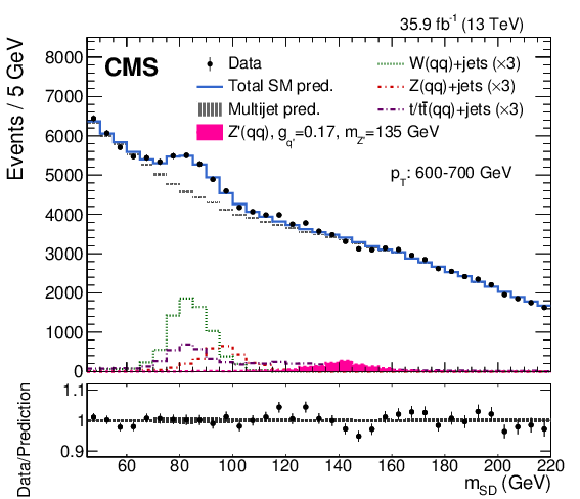
png pdf |
Figure 6-b:
Soft-drop jet mass distribution for the ${p_{\mathrm {T}}}$ range of the fit from 600 to 700 GeV. Data are shown as black points. The multijet background prediction, including uncertainties, is shown by the shaded bands. Contributions from the W and Z boson, and top quark background processes, and a hypothetical Z' boson signal at a mass of 135 GeV are also indicated. In the bottom panel, the ratio of the data to the background prediction, including uncertainties, is shown. |
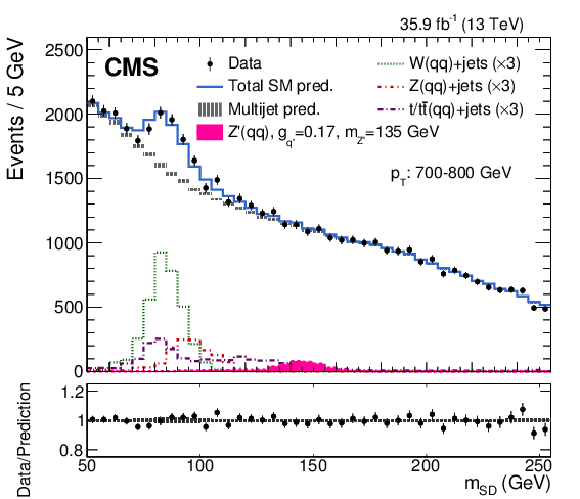
png pdf |
Figure 6-c:
Soft-drop jet mass distribution for the ${p_{\mathrm {T}}}$ range of the fit from 700 to 800 GeV. Data are shown as black points. The multijet background prediction, including uncertainties, is shown by the shaded bands. Contributions from the W and Z boson, and top quark background processes, and a hypothetical Z' boson signal at a mass of 135 GeV are also indicated. In the bottom panel, the ratio of the data to the background prediction, including uncertainties, is shown. |
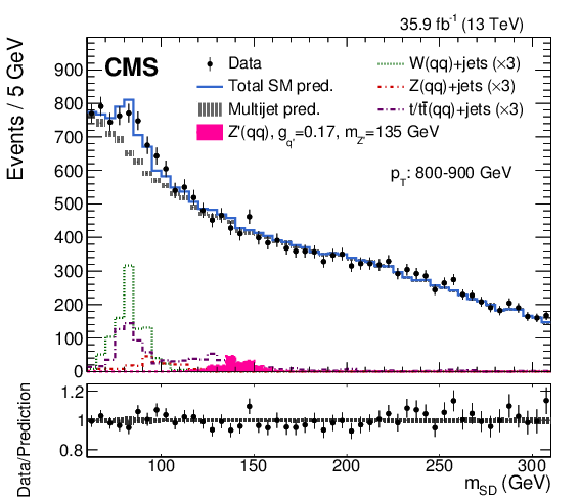
png pdf |
Figure 6-d:
Soft-drop jet mass distribution for the ${p_{\mathrm {T}}}$ range of the fit from 800 to 900 GeV. Data are shown as black points. The multijet background prediction, including uncertainties, is shown by the shaded bands. Contributions from the W and Z boson, and top quark background processes, and a hypothetical Z' boson signal at a mass of 135 GeV are also indicated. In the bottom panel, the ratio of the data to the background prediction, including uncertainties, is shown. |
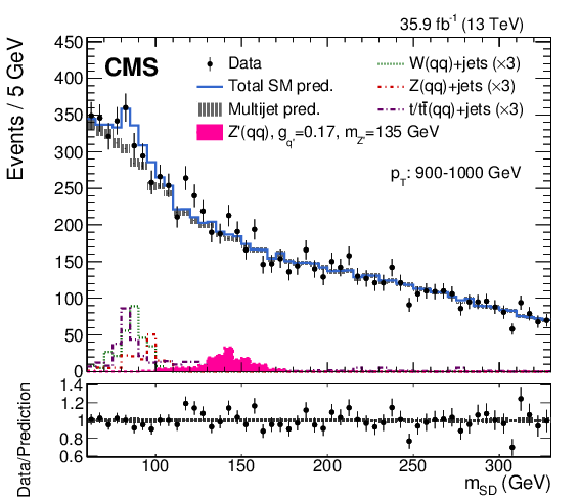
png pdf |
Figure 6-e:
Soft-drop jet mass distribution for the ${p_{\mathrm {T}}}$ range of the fit from 900 to 1000 GeV. Data are shown as black points. The multijet background prediction, including uncertainties, is shown by the shaded bands. Contributions from the W and Z boson, and top quark background processes, and a hypothetical Z' boson signal at a mass of 135 GeV are also indicated. In the bottom panel, the ratio of the data to the background prediction, including uncertainties, is shown. |
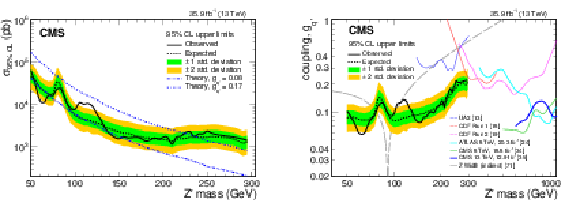
png pdf |
Figure 7:
The 95% CL upper limits on the Z' boson production cross section compared to theoretical cross sections (left) and on the quark coupling $g_{\rm q^{\prime}}$ as a function of resonance mass for a leptophobic Z' resonance that only couples to quarks (right). The observed limits (solid), expected limits (dashed) and their variation at the 1 and 2 standard deviation levels (shaded bands) are shown. Limits from other relevant searches and an indirect constraint on a potential Z' signal from the SM Z boson width [72] are also shown. |
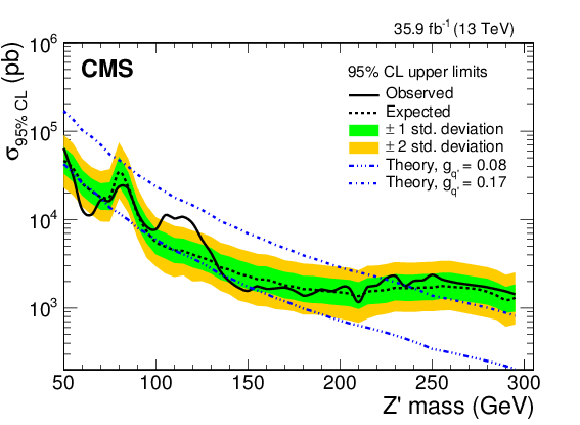
png pdf |
Figure 7-a:
The 95% CL upper limits on the Z' boson production cross section compared to theoretical cross sections as a function of resonance mass for a leptophobic Z' resonance that only couples to quarks. The observed limits (solid), expected limits (dashed) and their variation at the 1 and 2 standard deviation levels (shaded bands) are shown. Limits from other relevant searches and an indirect constraint on a potential Z' signal from the SM Z boson width [72] are also shown. |

png pdf |
Figure 7-b:
The 95% CL upper limits on the quark coupling $g_{\rm q^{\prime}}$ as a function of resonance mass for a leptophobic Z' resonance that only couples to quarks. The observed limits (solid), expected limits (dashed) and their variation at the 1 and 2 standard deviation levels (shaded bands) are shown. Limits from other relevant searches and an indirect constraint on a potential Z' signal from the SM Z boson width [72] are also shown. |

png pdf |
Figure 8:
The 95% CL observed (solid red) and expected (dashed red) excluded regions in the plane of dark matter particle mass ($m_{\rm DM}$) vs. mediator mass ($m_{\rm Med}$), for vector mediators. A branching fraction of 100% is assumed for a leptophobic vector mediator decaying to dijets. The exclusion is computed for a quark coupling choice $g_{q} = $ 0.25 and for a dark matter coupling $g_{\rm DM} = $ 1. The excluded regions from the dijet resolved analysis (blue dot dashed lines) using early 2016 data [35] are also shown. Results are compared to constraints from the cosmological relic density of DM (light gray) determined from astrophysical measurements [74,75] and MadDM version 2.0.6 [76,77] as described in Ref. [78]. |
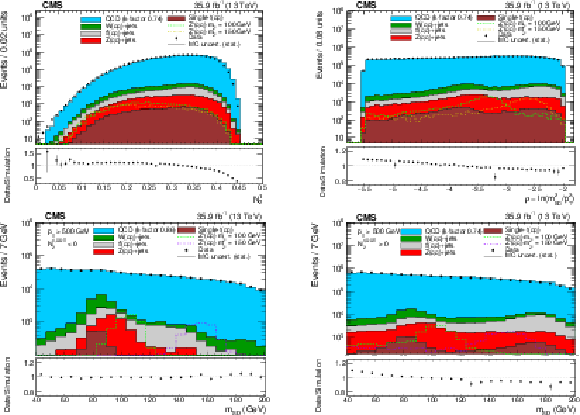
png pdf |
Figure 9:
Distributions of data (points) and simulated backgrounds (histograms) of the leading ${p_{\mathrm {T}}}$ jet $N_2^{1}$ (top left) and $\rho $ (top right) observables, after the kinematic selection. The soft-drop jet mass distributions for the passing (bottom left) and failing (bottom right) region, defined by the $N_2^{1,\text {DDT}}$ selection, are also shown. The decorrelation ensures that the shape of the multijet mass distribution in both regions is unaffected by the $N_2^{1,\text {DDT}}$ selection for different ${p_{\mathrm {T}}}$ ranges. Dashed lines illustrate the signal contribution for different Z' boson masses. The multijet processes (QCD) dominate the background component, with subdominant contributions from inclusive SM W, Z, and ${\mathrm{t} {}\mathrm{\bar{t}}}$ and single top quark processes. The QCD simulation is scaled by an overall factor of 0.74 to match the data yield. Residual differences between data and simulation demonstrate the need for a background estimation method based on control samples in data. |

png pdf |
Figure 9-a:
Distributions of data (points) and simulated backgrounds (histograms) of the leading ${p_{\mathrm {T}}}$ jet $N_2^{1}$, after the kinematic selection. Dashed lines illustrate the signal contribution for different Z' boson masses. The multijet processes (QCD) dominate the background component, with subdominant contributions from inclusive SM W, Z, and ${\mathrm{t} {}\mathrm{\bar{t}}}$ and single top quark processes. The QCD simulation is scaled by an overall factor of 0.74 to match the data yield. Residual differences between data and simulation demonstrate the need for a background estimation method based on control samples in data. |
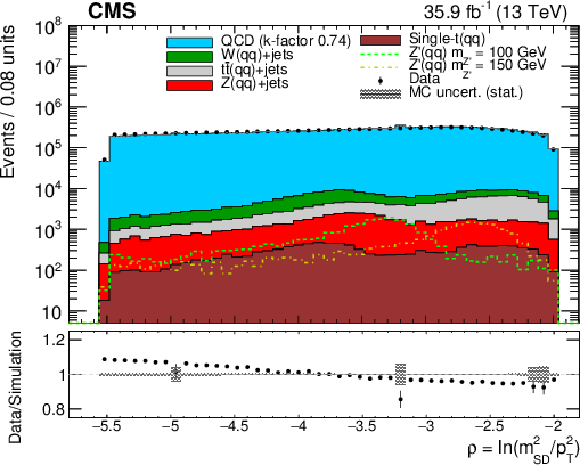
png pdf |
Figure 9-b:
Distributions of data (points) and simulated backgrounds (histograms) of the $\rho $ observable, after the kinematic selection. Dashed lines illustrate the signal contribution for different Z' boson masses. The multijet processes (QCD) dominate the background component, with subdominant contributions from inclusive SM W, Z, and ${\mathrm{t} {}\mathrm{\bar{t}}}$ and single top quark processes. The QCD simulation is scaled by an overall factor of 0.74 to match the data yield. Residual differences between data and simulation demonstrate the need for a background estimation method based on control samples in data. |

png pdf |
Figure 9-c:
The soft-drop jet mass distribution for the passing region, defined by the $N_2^{1,\text {DDT}}$ selection, is shown. The decorrelation ensures that the shape of the multijet mass distribution is unaffected by the $N_2^{1,\text {DDT}}$ selection for different ${p_{\mathrm {T}}}$ ranges. Dashed lines illustrate the signal contribution for different Z' boson masses. The multijet processes (QCD) dominate the background component, with subdominant contributions from inclusive SM W, Z, and ${\mathrm{t} {}\mathrm{\bar{t}}}$ and single top quark processes. The QCD simulation is scaled by an overall factor of 0.74 to match the data yield. Residual differences between data and simulation demonstrate the need for a background estimation method based on control samples in data. |
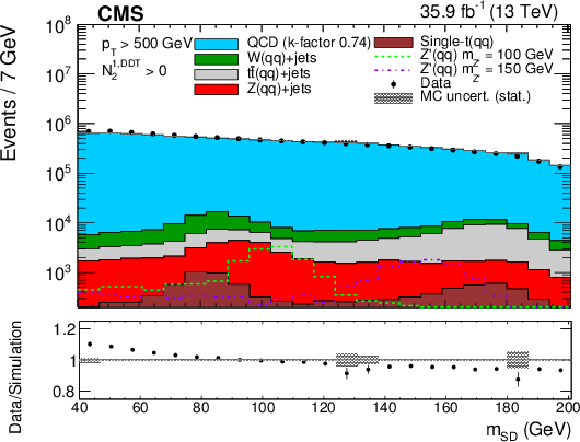
png pdf |
Figure 9-d:
The soft-drop jet mass distribution for the failing region, defined by the $N_2^{1,\text {DDT}}$ selection, is shown. The decorrelation ensures that the shape of the multijet mass distribution is unaffected by the $N_2^{1,\text {DDT}}$ selection for different ${p_{\mathrm {T}}}$ ranges. Dashed lines illustrate the signal contribution for different Z' boson masses. The multijet processes (QCD) dominate the background component, with subdominant contributions from inclusive SM W, Z, and ${\mathrm{t} {}\mathrm{\bar{t}}}$ and single top quark processes. The QCD simulation is scaled by an overall factor of 0.74 to match the data yield. Residual differences between data and simulation demonstrate the need for a background estimation method based on control samples in data. |

png pdf |
Figure 10:
Soft-drop jet mass distribution for the passing region and combined ${p_{\mathrm {T}}}$ categories. The multijet background prediction in the passing region is obtained using the failing region and the pass-fail ratio $R_{\rm p/f}(m_\text {SD}, {p_{\mathrm {T}}})$. Data are shown as black points. The multijet background prediction, including uncertainties, is shown by the shaded bands. Contributions from the W and Z boson, and top quark background processes, and a hypothetical Z' boson signal at a mass of 135 GeV are also indicated. The features at 45, 185, 220 and 255 GeV in the $m_{\rm SD}$ distribution are due to the kinematic selection on $\rho $, which affects each ${p_{\mathrm {T}}} $ category differently. In the bottom panel, the ratio of the data to the background prediction, including uncertainties, is shown. |

png pdf |
Figure 11:
The observed p-value, obtained from the fit to data, as a function of the Z' boson mass. The maximum local observed $\text {p}$-value, at 115 GeV, is 1.72$ \times 10^{-3}$ and corresponds to 2.9 standard deviations from the background-only expectation, and the global p-value, calculated over the probed mass range, corresponds to 0.0138 and 2.2 standard deviations. |
| Tables | |
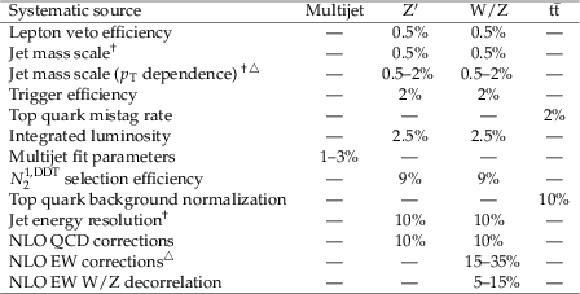
png pdf |
Table 1:
Summary of the systematic uncertainties for signal and background processes and their relative size. The symbol $^\triangle $ denotes uncertainties decorrelated per $ {p_{\mathrm {T}}} $ bin in the 500-1000 GeV range. The symbol $^\dagger $ denotes a shape uncertainty in the peaking SM W and Z boson backgrounds and Z' boson signal shape. A long dash ($ --- $) indicates that the uncertainty does not apply. |
| Summary |
| A search for a vector resonance (Z') decaying into a quark-antiquark pair and reconstructed as a single jet has been presented, using a data set comprising proton-proton collisions at $\sqrt{s} = $ 13 TeV, corresponding to an integrated luminosity of 35.9 fb$^{-1}$. Novel substructure techniques are employed to identify a jet containing a Z' boson candidate over a smoothly falling soft-drop jet mass distribution in data. No significant excess above the SM prediction is observed, and 95% confidence level upper limits are set on the Z' boson coupling to quarks, $g_{\rm q^{\prime}}$, as a function of the Z' boson mass. Coupling values of $g_{\rm q^{\prime}} > 0.25$ are excluded over the Z' mass range from 50 to 300 GeV, with strong constraints for masses less than 200 GeV. The results obtained for masses from 50 to 100 GeV represent the first direct limits to be published in this range. Limits are set on a simplified model of dark matter mediators that only couple to quarks and dark matter particles, excluding vector mediators with masses between 50 and 300 GeV, and using a universal quark coupling $g_{\rm q} = $ 0.25 and a dark matter coupling $g_{\rm DM} = $ 1.0. |
| References | ||||
| 1 | L. A. Anchordoqui et al. | Dijet signals for low mass strings at the LHC | PRL 101 (2008) 241803 | 0808.0497 |
| 2 | S. Cullen, M. Perelstein, and M. E. Peskin | TeV strings and collider probes of large extra dimensions | PRD 62 (2000) 055012 | hep-ph/0001166 |
| 3 | J. L. Hewett and T. G. Rizzo | Low-energy phenomenology of superstring inspired E(6) models | PR 183 (1989) 193 | |
| 4 | U. Baur, I. Hinchliffe, and D. Zeppenfeld | Excited quark production at hadron colliders | Int. J. Mod. Phys. A 2 (1987) 1285 | |
| 5 | U. Baur, M. Spira, and P. M. Zerwas | Excited quark and lepton production at hadron colliders | PRD 42 (1990) 815 | |
| 6 | P. H. Frampton and S. L. Glashow | Chiral color: An alternative to the Standard Model | PLB 190 (1987) 157 | |
| 7 | R. S. Chivukula, A. Farzinnia, E. H. Simmons, and R. Foadi | Production of massive color-octet vector bosons at next-to-leading order | PRD 85 (2012) 054005 | 1111.7261 |
| 8 | E. H. Simmons | Coloron phenomenology | PRD 55 (1997) 1678 | hep-ph/9608269 |
| 9 | T. Han, I. Lewis, and Z. Liu | Colored resonant signals at the LHC: Largest rate and simplest topology | JHEP 12 (2010) 085 | 1010.4309 |
| 10 | E. Eichten, I. Hinchliffe, K. D. Lane, and C. Quigg | Super collider physics | Rev. Mod. Phys. 56 (1984) 579 | |
| 11 | L. Randall and R. Sundrum | An alternative to compactification | PRL 83 (1999) 4690 | hep-th/9906064 |
| 12 | UA1 Collaboration | Two jet mass distributions at the CERN proton-anti-proton collider | PLB 209 (1988) 127 | |
| 13 | UA2 Collaboration | A measurement of two jet decays of the $ W $ and $ Z $ bosons at the CERN $ \bar{\text{p}} \text{p} $ collider | Z. Phys. C 49 (1991) 17 | |
| 14 | UA2 Collaboration | A search for new intermediate vector mesons and excited quarks decaying to two jets at the CERN $ \bar{\text{p}} \text{p} $ collider | NPB 400 (1993) 3 | |
| 15 | CDF Collaboration | The two jet invariant mass distribution at $ \sqrt{s} = $ 1.8 TeV | PRD 41 (1990) 1722 | |
| 16 | CDF Collaboration | Search for quark compositeness, axigluons and heavy particles using the dijet invariant mass spectrum observed in $ \text{p} \bar{\text{p}} $ collisions | PRL 71 (1993) 2542 | |
| 17 | CDF Collaboration | Search for new particles decaying to dijets in $ \text{p} \bar{\text{p}} $ collisions at $ \sqrt{s} = $ 1.8 TeV | PRL 74 (1995) 3538 | hep-ex/9501001 |
| 18 | CDF Collaboration | Search for new particles decaying to dijets at CDF | PRD 55 (1997) 5263 | hep-ex/9702004 |
| 19 | CDF Collaboration | Search for new particles decaying into dijets in proton-antiproton collisions at $ \sqrt{s} = $ 1.96 TeV | PRD 79 (2009) 112002 | 0812.4036 |
| 20 | D0 Collaboration | Search for new particles in the two jet decay channel with the D0 detector | PRD 69 (2004) 111101 | hep-ex/0308033 |
| 21 | ATLAS Collaboration | Search for new particles in two-jet final states in 7 TeV proton-proton collisions with the ATLAS detector at the LHC | PRL 105 (2010) 161801 | 1008.2461 |
| 22 | ATLAS Collaboration | Search for new physics in dijet mass and angular distributions in pp collisions at $ \sqrt{s} = $ 7 TeV measured with the ATLAS detector | New J. Phys. 13 (2011) 053044 | 1103.3864 |
| 23 | ATLAS Collaboration | Search for new physics in the dijet mass distribution using 1$ fb$^{-1} of pp collision data at $ \sqrt{s} = $ 7 TeV collected by the ATLAS detector | PLB 708 (2012) 37 | 1108.6311 |
| 24 | ATLAS Collaboration | ATLAS search for new phenomena in dijet mass and angular distributions using pp collisions at $ \sqrt{s} = $ 7 TeV | JHEP 01 (2013) 029 | 1210.1718 |
| 25 | ATLAS Collaboration | Search for new phenomena in the dijet mass distribution using pp collision data at $ \sqrt{s} = $ 8 TeV with the ATLAS detector | PRD 91 (2015) 052007 | 1407.1376 |
| 26 | ATLAS Collaboration | Search for new phenomena in dijet mass and angular distributions from pp collisions at $ \sqrt{s} = $ 13 TeV with the ATLAS detector | PLB 754 (2016) 302 | 1512.01530 |
| 27 | ATLAS Collaboration | Search for new phenomena in dijet events using 37 fb$^{-1} of pp collision data collected at $ \sqrt{s} = $ 13 TeV with the ATLAS detector | Submitted to PRD | 1703.09127 |
| 28 | CMS Collaboration | Search for dijet resonances in 7 TeV pp collisions at CMS | PRL 105 (2010) 211801 | CMS-EXO-10-010 1010.0203 |
| 29 | CMS Collaboration | Search for resonances in the dijet mass spectrum from 7 TeV pp collisions at CMS | PLB 704 (2011) 123 | CMS-EXO-11-015 1107.4771 |
| 30 | CMS Collaboration | Search for narrow resonances and quantum black holes in inclusive and b-tagged dijet mass spectra from pp collisions at $ \sqrt{s} = $ 7 TeV | JHEP 01 (2013) 013 | CMS-EXO-11-094 1210.2387 |
| 31 | CMS Collaboration | Search for narrow resonances using the dijet mass spectrum in pp collisions at $ \sqrt{s} = $ 8 TeV | PRD 87 (2013) 114015 | CMS-EXO-12-016 1302.4794 |
| 32 | CMS Collaboration | Search for resonances and quantum black holes using dijet mass spectra in proton-proton collisions at $ \sqrt{s} = $ 8 TeV | PRD 91 (2015) 052009 | CMS-EXO-12-059 1501.04198 |
| 33 | CMS Collaboration | Search for narrow resonances decaying to dijets in proton-proton collisions at $ \sqrt{s} = $ 13 TeV | PRL 116 (2016) 071801 | CMS-EXO-15-001 1512.01224 |
| 34 | CMS Collaboration | Search for narrow resonances in dijet final states at $ \sqrt{s} = $ 8 TeV with the novel CMS technique of data scouting | PRL 117 (2016) 031802 | CMS-EXO-14-005 1604.08907 |
| 35 | CMS Collaboration | Search for dijet resonances in proton-proton collisions at $ \sqrt{s} = $ 13 TeV and constraints on dark matter and other models | PLB 769 (2017) 520 | CMS-EXO-16-032 1611.03568 |
| 36 | CMS Collaboration | Search for low mass vector resonances decaying to quark-antiquark pairs in proton-proton collisions at $ \sqrt{s} = $ 13 TeV | PRL 119 (2017) 111802 | CMS-EXO-16-030 1705.10532 |
| 37 | B. A. Dobrescu and F. Yu | Coupling-mass mapping of dijet peak searches | PRD 88 (2013) 035021 | 1306.2629 |
| 38 | D. Abercrombie et al. | Dark matter benchmark models for early LHC Run-2 searches: Report of the ATLAS/CMS Dark Matter Forum | 1507.00966 | |
| 39 | CMS Collaboration | The CMS trigger system | JINST 12 (2017) 1020 | CMS-TRG-12-001 1609.02366 |
| 40 | CMS Collaboration | The CMS experiment at the CERN LHC | JINST 3 (2008) S08004 | CMS-00-001 |
| 41 | J. Alwall et al. | The automated computation of tree-level and next-to-leading order differential cross sections, and their matching to parton shower simulations | JHEP 07 (2014) 079 | 1405.0301 |
| 42 | J. Alwall et al. | Comparative study of various algorithms for the merging of parton showers and matrix elements in hadronic collisions | EPJC 53 (2008) 473 | 0706.2569 |
| 43 | S. Frixione, P. Nason, and C. Oleari | Matching NLO QCD computations with parton shower simulations: the POWHEG method | JHEP 11 (2007) 070 | 0709.2092 |
| 44 | T. Sjostrand et al. | An introduction to PYTHIA 8.2 | CPC 191 (2015) 159 | 1410.3012 |
| 45 | CMS Collaboration | Event generator tunes obtained from underlying event and multiparton scattering measurements | EPJC 76 (2016) 155 | CMS-GEN-14-001 1512.00815 |
| 46 | GEANT4 Collaboration | GEANT4---a simulation toolkit | NIMA 506 (2003) 250 | |
| 47 | NNPDF Collaboration | Parton distributions for the LHC run II | JHEP 04 (2015) 040 | 1410.8849 |
| 48 | CMS Collaboration | Search for dark matter produced with an energetic jet or a hadronically decaying W or Z boson at $ \sqrt{s} = $ 13 TeV | JHEP 07 (2017) 014 | CMS-EXO-16-037 1703.01651 |
| 49 | S. Kallweit et al. | NLO electroweak automation and precise predictions for W+multijet production at the LHC | JHEP 04 (2015) 012 | 1412.5157 |
| 50 | S. Kallweit et al. | NLO QCD+EW predictions for V+jets including off-shell vector-boson decays and multijet merging | JHEP 04 (2016) 021 | 1511.08692 |
| 51 | S. Kallweit et al. | NLO QCD+EW automation and precise predictions for V+multijet production | in Proceedings, 50th Rencontres de Moriond, QCD and high energy interactions, p. 121 2015 | 1505.05704 |
| 52 | J. M. Lindert et al. | Precise predictions for V+jets dark matter backgrounds | 1705.04664 | |
| 53 | CMS Collaboration | Particle-flow reconstruction and global event description with the CMS detector | Submitted to JINST | CMS-PRF-14-001 1706.04965 |
| 54 | M. Cacciari, G. P. Salam, and G. Soyez | The anti-$ k_t $ jet clustering algorithm | JHEP 04 (2008) 063 | 0802.1189 |
| 55 | M. Cacciari, G. P. Salam, and G. Soyez | FastJet user manual | EPJC 72 (2012) 1896 | 1111.6097 |
| 56 | D. Bertolini, P. Harris, M. Low, and N. Tran | Pileup per particle identification | JHEP 10 (2014) 059 | 1407.6013 |
| 57 | CMS Collaboration | Determination of jet energy calibration and transverse momentum resolution in CMS | JINST 6 (2011) 11002 | CMS-JME-10-011 1107.4277 |
| 58 | CMS Collaboration | Jet energy scale and resolution in the CMS experiment in pp collisions at 8 TeV | JINST 12 (2017) 2014 | CMS-JME-13-004 1607.03663 |
| 59 | D. Krohn, J. Thaler, and L.-T. Wang | Jet trimming | JHEP 02 (2010) 084 | 0912.1342 |
| 60 | M. Dasgupta, A. Fregoso, S. Marzani, and G. P. Salam | Towards an understanding of jet substructure | JHEP 09 (2013) 029 | 1307.0007 |
| 61 | A. J. Larkoski, S. Marzani, G. Soyez, and J. Thaler | Soft drop | JHEP 05 (2014) 146 | 1402.2657 |
| 62 | J. Dolen et al. | Thinking outside the ROCs: Designing Decorrelated Taggers (DDT) for jet substructure | JHEP 05 (2016) 156 | 1603.00027 |
| 63 | I. Moult, L. Necib, and J. Thaler | New angles on energy correlation functions | JHEP 12 (2016) 153 | 1609.07483 |
| 64 | S. A. Dudani | The distance-weighted k-nearest-neighbor rule | IEEE Transactions on Systems, Man, and Cybernetics SMC-6 (1976) 325 | |
| 65 | CMS Collaboration | Identification of b-quark jets with the CMS experiment | JINST 8 (2013) 4013 | CMS-BTV-12-001 1211.4462 |
| 66 | R. A. Fisher | On the interpretation of $ \chi^{2} $ from contingency tables, and the calculation of P | Journal of the Royal Statistical Society 85 (1922) 87 | |
| 67 | CMS Collaboration | CMS luminosity measurements for the 2016 data taking period | CMS-PAS-LUM-17-001 | CMS-PAS-LUM-17-001 |
| 68 | T. Junk | Confidence level computation for combining searches with small statistics | NIMA 434 (1999) 435 | hep-ex/9902006 |
| 69 | A. L. Read | Presentation of search results: the $ \rm CL_s $ technique | JPG 28 (2002) 2693 | |
| 70 | G. Cowan, K. Cranmer, E. Gross, and O. Vitells | Asymptotic formulae for likelihood-based tests of new physics | EPJC 71 (2011) 1554 | 1007.1727 |
| 71 | E. Gross and O. Vitells | Trial factors or the look elsewhere effect in high energy physics | EPJC 70 (2010) 525 | 1005.1891 |
| 72 | B. A. Dobrescu and C. Frugiuele | Hidden GeV-scale interactions of quarks | PRL 113 (2014) 061801 | 1404.3947 |
| 73 | G. Busoni et al. | Recommendations on presenting LHC searches for missing transverse energy signals using simplified $ s $-channel models of dark matter | 1603.04156 | |
| 74 | WMAP Collaboration | Wilkinson Microwave Anisotropy Probe (WMAP) three year results: implications for cosmology | Astrophys. J. Suppl. 170 (2007) 377 | astro-ph/0603449 |
| 75 | Planck Collaboration | Planck 2013 results. XVI. Cosmological parameters | Astron. Astrophys. 571 (2014) A16 | 1303.5076 |
| 76 | M. Backovic, K. Kong, and M. McCaskey | MadDM v.1.0: Computation of dark matter relic abundance using MadGraph5 | Phys. Dark Univ. 5 (2014) 18 | 1308.4955 |
| 77 | M. Backovic et al. | Direct detection of dark matter with MadDM v.2.0 | Phys. Dark Univ. 9 (2015) 37 | 1505.04190 |
| 78 | T. du Pree, K. Hahn, P. Harris, and C. Roskas | Cosmological constraints on dark matter models for collider searches | 1603.08525 | |

|
Compact Muon Solenoid LHC, CERN |

|

|

|

|

|

|